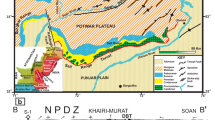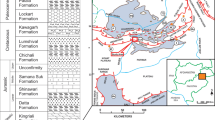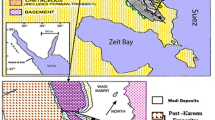Abstract
Stylolite-related fractures are rare diagenetic features (1% in volume) in Atoka (Carboniferous) bank carbonates in Eddy County, New Mexico, U.S.A. The fractures are often wedge- to curvilinear-shaped, vertical to subvertical, and their wider ends terminate at the seams of major stylolites. The associated stylolites are centimeters in size, low to medium amplitude (up to 1.5cm) and some of them are fabric selective forming at matrix-grain and matrix-cement boundaries. Fractures are filled with predominantly saddle dolomite and late calcite cements. Fracture size ranges from microscopic to 1cm, and they have a width less than 1 mm. A close coexistence of fractures with stylolites suggests that fractures have formed synchronously with the stylolites. In Atoka carbonates, stylolites were formed by progressive burial that is evidence by bedding-parallel or subparallel orientation and different mineral associations along stylolites and also at near areas. These minerals are commonly late calcite and saddle dolomite. Soon after initial stylolitization, dissolved material and/or formation water and surface morphology of stylolites caused localized stress differentiation around stylolite. Compaction differences of less soluble parts at the both sides of stylolitic-highs or lows such as column/peak or waveform result in breakage of less soluble parts above or below column/peak or wave-form. Later wedge-shaped fractures are occluded by late cements provided by stylolitization or stylolitic-channels carring cement-generating fluids from an external source such as dewatering of adjacent shales. Stable isotope values of saddle dolomite (δ18O=−3.5 to −4.0‰ PDB; δ13C=+0.04 to +0.67‰ PDB) and late calcite (δ18O=−5.4‰ PDB; δ13C=+0.7‰ PDB) suggest precipitation at paleotemperatures of 52–55°C for dolomite and 42°C for late calcite based on oxygen values. The temperatures correspond to burial depths of approximately 1450–1600m for dolomite and 1000 m for calcite under present-day conditions, assuming a geothermal gradient of 22°C/km and a surface temperature of 20°C (well data).
Similar content being viewed by others
References
ANDREWS, L.M. and RAILSBACK, L.B., 1997, Controls on stylolite development: Morphologic, lithologic, and temperal evidence from bedding-parallel and transverse stylolites from the U.S. Appalachians:Journal of Geology, v. 105, p. 59–73.
BATHURST, R.G.C., 1975, Carbonate sediments and their diagenesis. Elsevier, Amsterdam, 658 p.
BAUERLE, G., BORNEMANN, O., MAUTHE, F., and MICHALZIK, D., 2000, Origin of stylolites in Upper Permian Zechstein anhydrite (Gorleben Salt Dome, Germany):Journal of Sedimentary Research, v. 70, p. 726–737.
BAYLY, B., 1986, A mechanism for development of stylolites:Journal of Geology, v. 94, p. 431–435.
BUXTON, T.M. and sibley, D.F., 1981, Pressure solution features in a shallow buried limestone:Journal of Sedimentary Petrology, v. 51, p. 19–26.
CHOQUETTE, P.W. and JAMES, N.P., 1987, Diagenesis in limestones — 3, The deep burial Environment:Geoscience Canada, v. 14, p. 3–35.
CHOUKROUNE, P., 1969, An example of mesoscopic analysis of concentric folding in limestone series:Tectophysics, v. 7, p. 57–70.
DICKSON, J.A.D. and COLEMAN, M.L., 1980, Changes in carbon and oxygen isotope composition during limestone diagenesis:Sedimantology, v. 27, p. 107–118.
DURNEY, D.W., 1972, Solution-transfer, an important geological deformation mechanism:Nature, v. 235, p. 315–317.
DRUMMOND, C.N. and SEXTON, D.N., 1998, Fractal structure of stylolites:Journal of Sedimentary Research, v. 68, p. 8–10.
ENGELDER, T., GEISER, P.A., and ALVAREZ, W., 1981, Role of pressure solution and dissolution in geology:Geology, v. 9, p. 44–45.
EPSTEIN, S., BUCHSBAUM, R., LOWENSTAM, H.A., and UREY, H.C., 1953, Revised carbonate-water isotopic temperature scale:Geological Society of America Bulletin, v. 64, p. 1315–1326.
EREN, M., 1993a, Petrophysical study of Pennsylvanian Atoka carbonate bank complex, Eddy County, New Mexico. Unpublished PhD Thesis, Texas Technical University, Lubbock, 261 p.
EREN, M., 1993b, Burial dolomitization within Atoka carbonates:Giornale di Geologia, v. 55, p. 171–176.
FRITZ, P. and SMITH, D.G.W., 1970, The isotopic composition of secondary dolomites:Geochimica Cosmochimica Acta, v. 34, p. 1161–1173.
HATCHER, R.D. Jr., 1990, Structural Geology: Principles, Concepts, and problems. Columbus, Merrill Publishing Company, 531 p.
KULANDER, B.R., BARTON, C.C., and DEAN, S.L., 1979, The application of fractography to core and outcrop fracture investigations: Morgantown, West Virginia, DOE METC/SP-79/3, 174 p.
LAND, L.S., 1985, The origin of massive dolomite:Journal of Geological Education, v. 33, p. 112–125.
LIND, I.L., 1993, Stylolites in chalk from Leg 130, Ontong Java Plateau:Proceedings of the Ocean Drilling Program (ODP) Scientific Results, no. 130, p. 445–451.
LLOYD, R.M., 1977, Porosity reduction by chemical compaction-stable isotope model (Abstract):American Association of Petroleum Geologists Bulletin, v. 61, p. 809.
NELSON, R.A., 1981, Significance of fracture sets associated with stylolite zones:American Association of Petroleum Geologists Bulletin, v. 65, p. 2417–2425.
PARK, W.C. and SCHOT, E.H., 1968, Stylolites: Their nature and origin:Journal of Sedimentary Petrology, v. 38, p. 175–191.
RAILSBACK, L.B., 1993, Lithologic controls on morhology of pressure — dissolution surfaces (Stylolites and dissolution seams) in Paleozoic carbonate rocks from the mideastern United States:Journal of Sedimentary Petrology, v. 63, p. 513–522.
TRURNIT, P., 1968, Analysis of pressure-solution contacts and classification of pressure-solution phenomena,in G. Müller and G.M. Friedman, eds., Recent Developments in Carbonate Sedimentology in Central Europe, Berlin, p. 75–84.
TUCKER, M.E. and WRIGHT, V.P., 1990, Carbonate Sedimentology. Oxford, Blackwell Science, 482 p.
TUCKER, M.E., 1991, Sedimentary Petrology. Oxford, Blackwell Science, 260 p.
WANLESS, H.R., 1979, Linestone response to stress: Pressure solution and dolomitization:Journal of Sedimentary Petrology, v. 49, p. 437–462.
WATTS, N.L., 1983, Microfractures in chalks of Albuskjell Field, Norwegian Sector, North Sea: possible origin and distribution:American Association of Petroleum Geologists Bulletin, v. 67, p. 201–234.
Author information
Authors and Affiliations
Corresponding author
Rights and permissions
About this article
Cite this article
Eren, M. Origin of stylolite related fractures in Atoka Bank Carbonates, Eddy County, New Mexico, U.S.A.. Carbonates Evaporites 20, 42–49 (2005). https://doi.org/10.1007/BF03175447
Published:
Issue Date:
DOI: https://doi.org/10.1007/BF03175447




